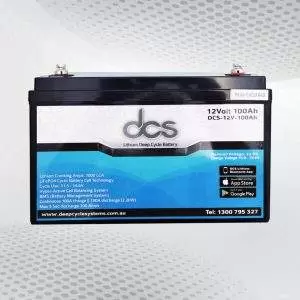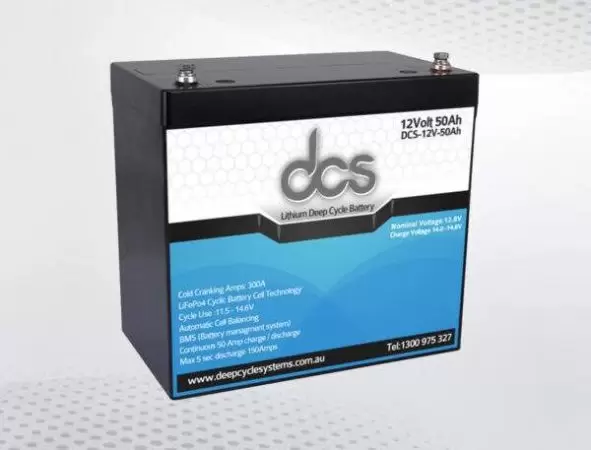Introduction In the diverse world of batteries, the Sealed 12 Volt Deep Cycle Battery holds a prestigious position, famed for its resilience and high performance. Let’s explore this powerhouse’s technical aspects, benefits, and maintenance and better understand its overall standing in the battery market.
Delving into the Sealed 12-Volt Deep Cycle Battery
The allure of the Sealed 12-Volt Deep Cycle Battery lies in its encapsulated design. This battery style doesn’t necessitate frequent top-ups with distilled water, simplifying its maintenance needs. However, its simplicity keeps its power capabilities intact. It can sustain heavy power loads, making it a prime choice for diverse applications. It’s a common sight in solar energy storage systems due to its dependable and consistent performance.
Marine equipment and recreational vehicles also benefit from this battery type’s robustness and durability. It offers a seamless combination of low maintenance and high power, making it an excellent solution for demanding power needs.
Understanding the Lead Acid Deep Cycle Battery Price
Deciphering the pricing dynamics of the lead acid deep cycle battery is crucial. This type of battery boasts an extensive lifespan and high power output, reflected in its cost. Prices are not standardised and can fluctuate based on factors such as the battery’s specifications, manufacturing brand, and the supplier from whom it’s purchased. On average, you might look at a range of £70 to £250 for a high-quality lead acid deep-cycle battery.
While the upfront cost may seem steep, it’s important to consider the long-term benefits. This battery is designed for substantial, heavy-duty use and has a notable capacity for power delivery. Thus, even at a higher Lead Acid Deep Cycle Battery Price point, the lead acid deep cycle battery offers value for money and is a solid investment for those needing reliable and robust power solutions.
Maximising Your Battery’s Lifespan
Adhering to the manufacturer’s recommended charging methods is paramount to ensure your battery endures. Avoiding overly deep discharges can extend your battery’s life and protect its performance. Remember that cleanliness is a key factor in battery longevity. By removing dust and dirt, you can prevent unnecessary wear and tear. Regular inspections for signs of damage or deterioration can allow for early detection and correction, further bolstering the lifespan of your battery.
Proper charging practices also play a significant role in battery upkeep. Invest in a high-quality charger and regularly check your battery’s power levels. A well-maintained battery is a lasting battery, and these steps can significantly aid in preserving your investment for the long haul.
Uncovering the Benefits of AGM Deep Cycle Battery
AGM (Absorbed Glass Mat) deep cycle batteries hold a unique position in the battery marketplace, recognised for their distinct advantages:
- Outstanding Discharge Rate: AGM batteries boast a fast and efficient power delivery, ideal for devices requiring substantial power quickly.
- Vibration Resistant: They demonstrate a high resistance to vibrations and shocks, ensuring durability and reliable performance.
- Low Maintenance: An AGM deep cycle battery does not require regular water top-ups, making it less laborious.
- Secure Design: The battery’s sealed design prevents acid leakage, offering enhanced safety.
- High Lifespan: Even under repeated charging and discharging cycles, AGM batteries tend to have a longer service life.
- Environmentally Friendly: These batteries produce fewer harmful emissions, making them a more eco-friendly power solution.
It’s worth noting that while AGM batteries come with a higher price tag, their durability, performance and ease of maintenance make them a cost-effective choice for the long term.
Evaluating the 12 Volt Sealed Deep Cycle Battery
Regarding the 12 Volt Sealed Deep Cycle Battery, it certainly holds its ground in terms of the benefits it brings to the table. One prominent advantage is the leak-proof design that effectively removes the risk of corrosive acid spillage. It also adds to the safety feature by not releasing harmful gases. Additionally, this battery type demonstrates a strong resilience to high power loads and deep discharge cycles, a characteristic uncommon amongst its counterparts.
Despite these taxing conditions, its performance remains consistent, and there is minimal effect on its overall lifespan. This robustness and safety features make the 12-Volt Sealed Deep Cycle Battery a considerable contender in the power solutions sector.
Identifying the Best Sealed Deep Cycle Battery
Determining the Best Sealed Deep Cycle Battery involves various factors. It’s not only about its ability to deliver high power but also its safety features, reliability, maintenance needs, and longevity. Below are some essential elements to consider:
-Energy Density
A high energy density means the battery can store substantial power in a compact form. This feature is particularly useful in space-limited applications.
– Discharge Depth
A deep-cycle battery should be capable of withstanding extensive discharge without affecting its performance. The ability to perform under heavy power loads is a key indicator of a robust battery.
– Maintenance Requirement
Minimal maintenance is always a plus. Sealed deep-cycle batteries that don’t require regular top-ups or constant monitoring are often preferred for their simplicity and convenience.
– Safety Features
A good sealed deep cycle battery should be designed with safety in mind. A leak-proof design, no emission of harmful gases, and a spill-proof construction are all desirable attributes.
– Price Point
Finally, cost is a crucial aspect. But remember, a high-quality sealed deep cycle battery may come with a higher price tag but offers superior performance and longevity.
While the above elements serve as a guide, individual needs and applications may require specific features. Consider your power requirements, usage, and environment before deciding.
Top Tips for Maintaining Deep Cycle Batteries
Proper maintenance is vital to ensure that your deep-cycle battery functions optimally. Here are a few crucial pointers to consider:
- Regular Inspection: Carry out routine checks to detect any potential issues early, such as bulging, leaks, or corrosion.
- Correct Charging: Adhere to the manufacturer’s guidelines for charging. Overcharging or discharging too deeply can negatively impact the battery’s lifespan.
- Optimal Storage: Store your batteries in a cool, dry place and avoid exposure to extreme temperatures.
- Cleanliness: Clean the battery terminals to prevent power loss and potential damage.
- Water Levels: Always ensure the water levels are adequate for wet cell batteries. Use distilled water to top up when necessary.
- Regular Usage: Batteries should be used regularly to keep them in good shape. Prolonged periods of inactivity can cause the battery to discharge and may reduce its lifespan.
- Battery Testing: Regular voltage checks ensure your battery functions properly. If there’s a sudden voltage drop, it may indicate a problem.
Charging Your Battery: Tips and Tricks
Charging your battery correctly is key to maintaining its lifespan and performance. Here are some effective strategies to ensure an efficient charging process:
Follow Manufacturer’s Instructions
Always adhere to the guidelines provided by the battery manufacturer. They offer the best advice for specific battery types and models.
Use the Right Charger
Ensure you use a charger compatible with your battery’s specifications. Mismatched chargers can result in inefficient charging and potentially damage the battery.
Regular Charging
It’s crucial to keep your batteries charged regularly. Extended periods of non-use can cause a battery to lose its charge, harming its overall performance and lifespan.
Avoid Overcharging
Overcharging can lead to overheating, reducing battery lifespan and potentially causing safety hazards. Always monitor your battery during charging to prevent overcharging.
Charge in a Cool, Dry Environment
Charging in a cooler environment can improve battery efficiency and reduce the risk of overheating. Avoid charging in direct sunlight or hot areas.
Keep Battery Clean
Ensure the battery and its terminals are clean before charging. Dust and dirt can interfere with the charging process.
Use a Smart Charger
If possible, use a smart charger. These devices can automatically adjust the charging process based on the battery’s current state, preventing overcharging and increasing efficiency.
Regularly Check Battery Power Levels
Regular checks can ensure your battery’s charge is optimal. Regular voltage checks can also help identify potential battery performance issues.
Implementing these strategies ensures your battery is charged efficiently and safely, maximising its performance and lifespan.
Diving into the Wet Cell Deep Cycle Battery
Wet Cell Deep Cycle Battery has a prominent place among the various types of batteries owing to their low cost and simple upkeep. They are traditionally filled with a liquid electrolyte, necessitating consistent replenishment with distilled water to prevent dehydration. A noteworthy characteristic of these batteries is that they generate hydrogen gas while charging. This necessitates proper ventilation for safe usage to avert an excessive accumulation of this gas, which could lead to potentially dangerous situations.
Although maintenance might seem tedious to some, their affordability and broad application across multiple industries make them popular. They are frequently utilised in applications where high power over extended periods is required, making them an essential cog in many power solutions.
Exploring Lithium-Ion Deep Cycle Battery
Delving into the world of Lithium-Ion Deep Cycle batteries, one is met with a wealth of attributes that set them apart. Their compact and lightweight form factor masks a high energy density, a trait that proves particularly beneficial in space-conscious applications. Unlike their lead-acid counterparts, these batteries have a more significant upfront investment. However, their longevity and low self-discharge rate render them a cost-effective solution in the long run.
They also do away with the need for regular maintenance, which might otherwise be cumbersome. These qualities and a more environmentally friendly profile have seen them gain traction in the market. Despite the higher initial expenditure, the efficiency and durability of Lithium-Ion Deep Cycle batteries make them a compelling choice for power solutions.
 FAQ’s
FAQ’s
1. What is a Deep Cycle Battery?
A deep-cycle battery is designed to deliver sustained power over an extended period. It can repeat charging and discharging cycles without significantly damaging its performance.
2. Are AGM and Sealed Deep Cycle Batteries the same?
AGM (Absorbed Glass Mat) and sealed deep cycle batteries are lead-acid batteries. However, AGM batteries have a unique design that uses a thin glass mat to absorb the battery acid, making them spill-proof and maintenance-free.
3. Why are Wet Cell Batteries called so?
Wet cell batteries are called so because they contain a liquid electrolyte. This design requires regular replenishment with distilled water to maintain optimal performance.
4. How should I maintain my Deep Cycle Battery?
Maintaining your deep cycle battery involves regular inspection, proper charging, cleanliness, optimal storage, and regular usage. For wet cell batteries, maintaining water levels is also essential.
5. Why is Lithium-Ion Deep Cycle Battery more expensive?
Lithium-Ion Deep Cycle Batteries have a high energy density, long lifespan, and require minimal maintenance. These superior features account for the higher cost compared to other types.
Conclusion
In conclusion, each type of deep cycle battery, whether sealed, wet cell or lithium-ion, offers unique benefits suited to specific power needs. From the long-lasting performance of a lead acid deep cycle battery to the maintenance-free convenience of a Sealed 12 Volt Deep Cycle Battery, the right choice depends on individual requirements. You can maximise your battery’s lifespan and efficiency by prioritising regular maintenance, appropriate charging, and timely inspections. Whether investing in a high-priced lithium-ion battery or a more affordable wet-cell battery, the return on investment lies in effectively understanding and catering to your power needs
| Other Good Articles to Read |
| Skank Blogs |
| Unreal Blogs |
| Tba Blogs |
| All City Forums |
| Dany Blogs |
| Refuge Blogs |
| The Music Blogs |
| Key Forums |
| The Big Blog Theory |
| Joe Blogs |
| Blogs 4 Me |
| Blogs Emon |
| Related Business Listings |
| Contact Directory |
| Local Business Profiles |



